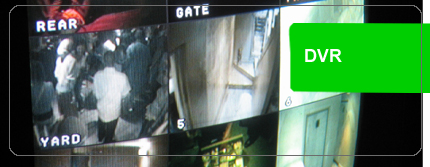


 |
 |
||
 |
|||
|
|
|||

According as amazing growth in computer hardware and software industry, image processing and storage device based on existing technology of computer was developed and launched in the market with a name of DVR just before millennium year 2000, and many companies entered into competition to develop more reliable DVR with high performance to be a forerunner in this field. PC-based DVR is a DVR basically includes PC system, hardware and operating system, with encoding and recording card, and it is a representative products to push conventional type of analog security equipment in the world security market.
|
DCT HAD CODEC MPEG-1 Wavelet ISDN UPS VGA |
Fixed focal length lens IR light MPEG MPEG-2 LAN T1 WAN |
![]()
Discrete cosine transform. Mathematical algorithm used to generate frequency representations of a block of video pixels. The DCT is an invertible, discrete orthogonal transformation between time and frequency domain. It can be either forward discrete cosine transform (FDCT) or inverse discrete cosine transform (IDCT).
![]()
A lens with a predetermined fixed focal length, a focusing control and a choice of iris functions.
![]()
Hole accumulated diode. A type of CCD sensor with a layer designed to accumulate holes (in the electronic sense), thus reducing noise level.
![]()
Infrared light, invisible to the human eye. It usually refers to wavelengths longer than 700 nm. Monochrome (B/W) cameras have extremely high sensitivity in the infrared region of the light spectrum.
![]()
Code/Decode. An encoder plus a decoder is an electronic device that compresses and decompresses digital signals. CODECs usually perform A/D and D/A conversion.
![]()
Motion Picture Experts Group. An ISO group of experts that has recommended manipulation of digital motion images. Today there are a couple of MPEG recommendations, of which the most well known are MPEG-1 and MPEG-2. The latter one is widely accepted for high definition digital television, as well as multimedia presentation
![]()
Standard for compressing progressive scanned images with audio. Bit rate is from 1.5 Mbps up to 3.5 Mbps.
![]()
The standard for compression of progressive scanned and interlaced video signals with high quality audio over a large range of compression rates with a range of bit rates from 1.5 to 100 Mbps. Accepted as a HDTV and DVD standard of video/audio encoding.
![]()
A particular type of video compression that is especially suitable for CCTV. Offers higher compression ratio with equal or better quality to JPEG.
![]()
Local Area Network. A short distance data communications network (typically within a building or campus) used to link together computers and peripheral devices (such as printers, CD ROMs and modems) under some form of standard control.
![]()
Integrated Services Digital Network. The newer generation telephone network, which uses 64 kb/s speed of transmission (being a digital network, the signal bandwidth is not expressed in kHz, but rather with a transmission speed). This is much faster than a normal PSTN telephone line. To use the ISDN network you have to talk to your communications provider, but in general a special set of interface units (like modems) are required.
![]()
A digital transmission link with a capacity of 1.544 Mbps. T1 uses two pairs of normal twisted wires. T1 lines are used for connecting networks across remote distances. Bridges and routers are used to connect LANs overT1 networks.
![]()
Uninterruptible power supply. These are power supplies used in the majority of high security systems, whose purpose is to back-up the system for at least 10 minutes without mains power. The duration of this depends on the size of the UPS, usually expressed in VA, and the current consumption of the system itself.
![]()
Wide area network. Is a data communications network that covers a relatively broad geographic area.
![]()
Video graphics array. Is an analog computer display standard.